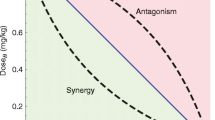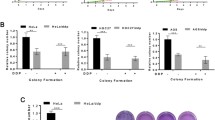Summary
When tumor cell density increases, the cytotoxic activity of certain anticancer agents, such as vincristine (VCR) and doxorubicin (DXR), progressively decreases. This phenomenon is termed the inoculum effect. Since VCR and DXR are less active in an acidic environment, we questioned whether the inoculum effects could have resulted from acidification of the medium that may have developed due to the high cell density. However, measurements of the cytotoxic activity of these agents in a pH-controlled medium revealed only a minor correction of the inoculum effects. Second, we wondered whether the inoculum effects that occurred at the high cell density might have been attributable to insufficient amounts of drugs to bind all the binding sites of the cells. To test this hypothesis, we used drug-resistant sublines, which required higher VCR or DXR concentrations for cell killing than did the parent cell line. When higher drug concentrations were used, the dose-response curves generated for low- and high-density cell populations became closer and overlapped each other, resulting in virtual disappearance of the inoculum effects. Measurements of cellular drug levels revealed that at a high cell density, cells accumulated much smaller amounts of both VCR and DXR in parallel with the positive inoculum effect. In contrast, when high concentrations of the drugs were used in drug-resistant cells, differences in the cellular drug contents between low and high cell densities became narrow. Cisplatin (DDP) belongs to a group of drugs that do not produce inoculum effects, and DDP's cytotoxic effects were not influenced by the pH-controlled medium or by the use of drug-resistant cell lines. These observations indicate that the inoculum effects are the result of the unavailability of VCR or DXR molecules to all cellular binding sites when cells at high densities are exposed to drugs. The drug concentration relative to cell density was apparently the major determinant for the inoculum effects seen in VCR- or DXR-induced cell killing.
Similar content being viewed by others
References
Arkin H, Ohnuma T, Holland JF, Averbuch SD (1988) Cellular glutathione-S-transferase characteristics in differential multidrug resistant human acute lymphoblastic MOLT-3 leukemia sublines. Proc Am Assoc Cancer Res 29:316
Arkin H, Ohnuma T, Kamen BA, Holland JF, Vallabhajosula S (1989) Multidrug resistance in a human leukemic cell line selected for resistance to trimetrexate. Cancer Res 49:6556
Basker MJ, Edmondson RA, Sutherland R (1979) Comparative antibacterial activity of azlocillin, mezlocillin, carbenecillin and ticarcillin and relative stability to beta-lactamases ofPseudomonas aeruginosa andKlebsiella aerogenes. Infection 7:67
Bodey GP, Pan T (1977) Mezlocillin: in vitro studies of a new broad-spectrum penicillin. Antimicrob Agents Chemother 11:74
Born R, Eichholtz-Wirth H (1981) Effect of different physiological conditions on the action of Adriamycin on Chinese hamster cells in vitro. Br J Cancer 44:2141
Ferguson PF, Phillips JR, Selner M, Cass CE (1984) Differential activity of vincristine and vinblastine against cultured cells. Cancer Res 44:3307
Herman TS, Teicher BA, Collins LS (1988) Effect of hypoxia and acidosis on the cytotoxicity of four platinum complexes at normal and hyperthermic temperatures. Cancer Res 48:2342
Hindenberg AA, Gervasoni JE Jr, Krishna S, Stewart VJ, Rosado M, Lutzky J, Bhalla K, Baker MA, Taub RN (1989) Intracellular distribution and pharmacokinetics of daunorubicin in anthracycline-sensitive and-resistant HL-60 cells. Cancer Res 49:4607
Minowada J, Ohnuma T, Moore GE (1972) Rosette-forming human lymphoid cell lines: I. Establishment and evidence for origin of thymus-derived lymphocytes. J Natl Cancer Inst 49:891
Mosmann T (1983) Rapid colorimetric assay for cellular growth and survival: application to proliferation and cytotoxicity assays. J Immunol Methods 65:55
Ohnuma T, Arkin H, Holland JF (1986) Effects of cell density of drug-induced cell kill kinetics in vitro (inoculum effect). Br J Cancer 54:415
Takemura Y, Kobayashi H, Miyachi H, Hayashi K, Sekiguchi S, Ohnuma T (1991) The influence of tumor cell density on cellular accumulation of doxorubicin or cisplatin in vitro. Cancer Chemother Pharmacol 27:417
Tannock IF, Rotin D (1989) Acid pH in tumors and its potential for therapeutic exploitation. Cancer Res 49:4373
Totsuka K, Oshima K, Mizoguchi H (1982) Vindesine receptors in cells of a human leukemia cell line. Br J Cancer 46:392
Young RC, Ozols FR, Myers CE (1981) The anthracycline antineoplastic drugs. New Engl J Med 305:139
Author information
Authors and Affiliations
Additional information
This work was supported in part by the United Leukemia Fund, Rego Park, New York; by Hayashibara Biochemical Laboratories, Inc., Okayama, Japan; by the T. J. Martell Foundation for Leukemia and Cancer Research, New York; and by the Chemotherapy Foundation, Inc., New York, USA
Rights and permissions
About this article
Cite this article
Kobayashi, H., Takemura, Y. & Ohnuma, T. Relationship between tumor cell density and drug concentration and the cytotoxic effects of doxorubicin or vincristine: mechanism of inoculum effects. Cancer Chemother. Pharmacol. 31, 6–10 (1992). https://doi.org/10.1007/BF00695987
Received:
Accepted:
Issue Date:
DOI: https://doi.org/10.1007/BF00695987




